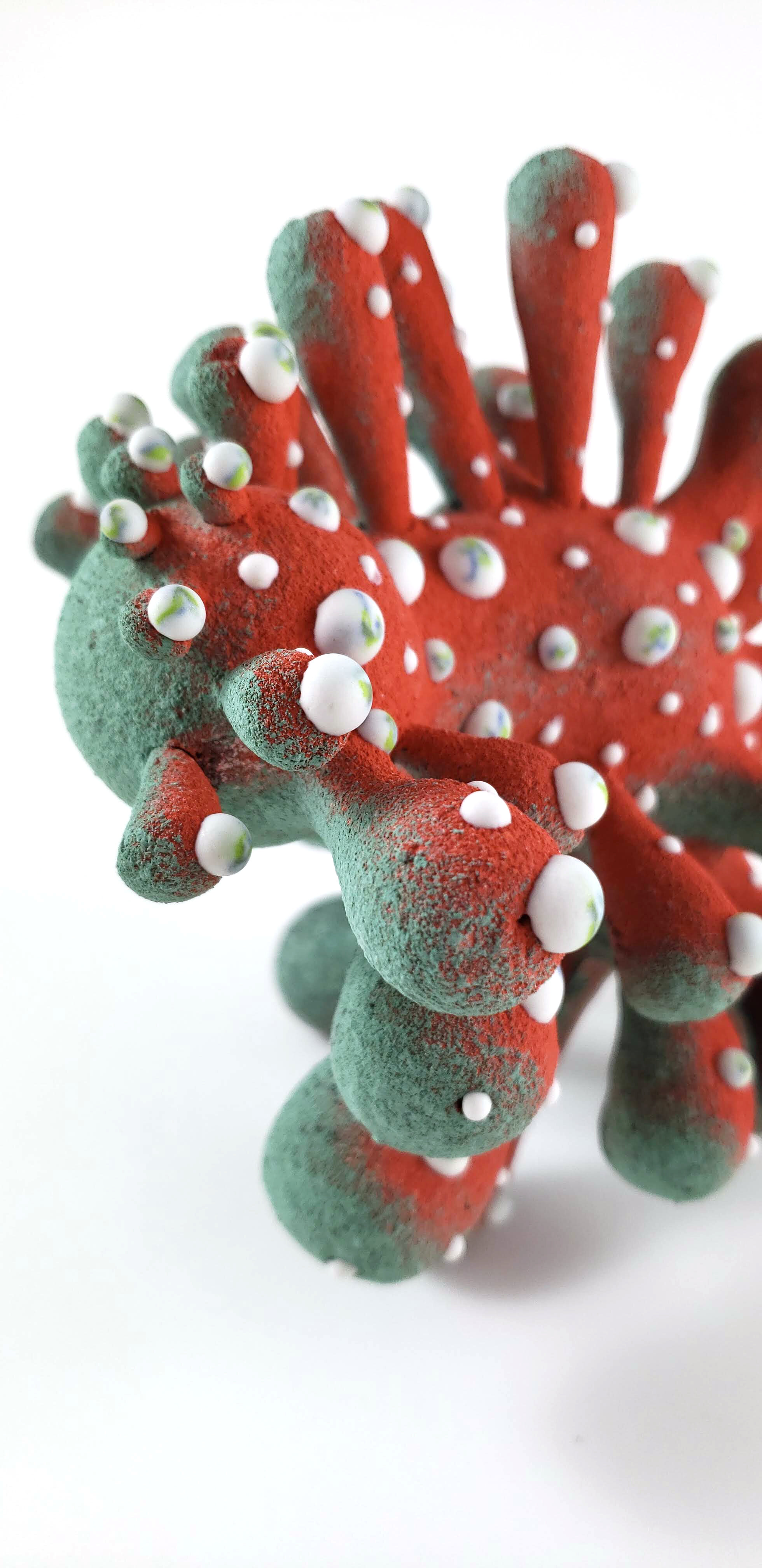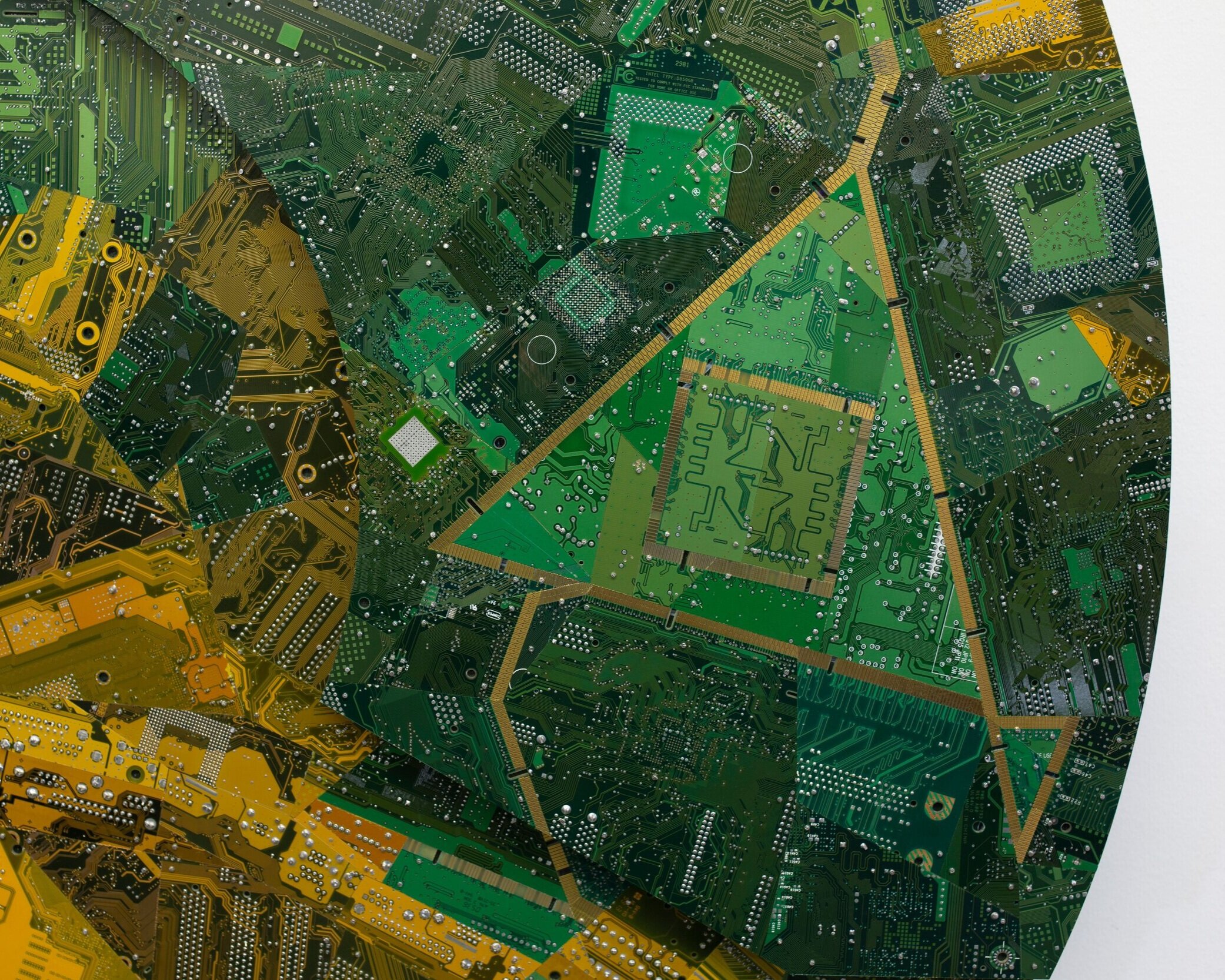Toni Losey
Toni Portrait with Once Was Red and Egg Series: Yellow Lichen and Burnt Orange, 2020.
COURTESY OF THE ARTIST
Toni Losey’s new sculptural work plays with organic forms as she further refines and develops her applications of glazes.
Toni Losey lives in Dartmouth, N.S., across the harbour from Halifax, where she finished her BFA at the Nova Scotia College of Art and Design University in 2017. As a student, she began to develop a series of sculptural pieces. That series continues, and has received favourable attention in both North America and Europe. Losey has been making pottery since the age of 14, and has worked as a production potter for over 15 years.
After some time spent in the corporate sector and raising a family, Toni renewed her commitment to ceramics. She continues to produce a much-collected line of functional pottery, while teaching courses in the ceramics department at NSCADU.
Losey will soon be working with a researcher from the University of Saskatchewan’s department of virology, exploring ideas for sculptures inspired by microscopic imaging. She will also be studying online with Matt and Rose Katz in order to develop a new lexicon of glaze solutions related to her sculptural direction. Losey describes these new directions as a “balancing act between abstraction and imaging realism.”
Toni Losey brings the discipline and technical mastery of her functional work to her relatively new sculptural work. While the functional pieces suggest leisure and comfort, the sculptures gesture towards unease. The pots are stable, resolved and confident, the sculptures open us to a reality of spiritual questioning and uncertainty. The sculptures have emotional weight, while the vessels have the solidity and considered balance of early Greek sculpture. Losey’s approach is not painterly; form and colour are integrated into a single expressive initiative. Despite this clear divergence of intentions, Losey feels both committed to and excited by both of her directions.
“Losey’s biological form sculptures are not literal models of biological forms; rather, they are expressive vehicles for the artist’s inner journey.”
As influences go, Losey's functional work grows out of an interest in the Art Deco period. Smoothly curved geometry and a limited palette of pastel colours generate an exquisite sense of solid and dependable function. Carefully exposed toasty-brown clay creates a rich counterpoint to the satiny and sometimes speckled glazes. The work is handsome, functional and well-made.
Toni Losey, Fade from Black, 2019. Earthenware, 117 x 84 x 84 cm.
COURTESY OF THE ARTIST
Losey’s sculptures reflect an openness to pushing the boundaries both of technique and content. Losey’s biological form sculptures are not literal models of biological forms; rather, they are expressive vehicles for the artist’s inner journey. What we notice in Losey’s new sculptural objects is the intensity and risk-taking that she brings to the journey.
Losey has alternated between these smaller pieces and larger forms as the work has evolved. The smaller pieces allow her to “push the details and the glaze further.” Her larger pieces are up to a metre in height, and involve wheel-thrown elements and hand building.
Losey names her pieces using abbreviated, coded titles that signify a type of personal and scientific nomenclature. NFL-00-12-57-1 is a smallish piece, about 14 centimetres in diameter, that “encompasses all the things I have been working towards — form, movement, colour.” The sculpture is made of earthenware and porcelain.
The form of NFL-00-12-57-1 is compact and composed of 30 or more pendulous appendages that radiate informally from a central and somewhat larger core. The drippy glaze buttons suggest a directional current, or force, stretching the melting glaze to the left side of the picture plane. The sculpture is perched on three of the larger lobes, suggesting the possibility of locomotion. The piece reads as organic, mobile and directional.
Toni Losey, Punk Virus (detail), 2020. Earthenware, 46 x 46 x 57 cm.
COURTESY OF THE ARTIST
The piece could be interpreted as plant or animal (or virus), with the clear suggestion of movement either by the piece, or by a force or forces acting upon it. The lurid coloration warns against contact. The glaze beads appear to be extruded by the rounded lobes, suggesting a gelatinous, organic nature. Because the form is unfamiliar, our perceptions are destabilized. Is this alive? Is it dangerous? Is this a model of something much smaller, or bigger? There is a hint of something sinister, even nightmarish. Losey’s meticulous construction adds to the illusion that the piece exists without human crafting. NFL-00-12-57-1 is both open and closed: open because of the complex negative spaces created between and around the lobes, and closed because there is a defensive closeness to the form, which is roughly spherical. The lack of a formal base allows the form to float visually, as if suspended in a non-gravitational or liquid environment. The commonplace becomes alien, and vaguely threatening.
Losey’s sculptures identify her as an artist who has new things to say. Her energy and growing skill set suggest that she will have much more to show us in future. Her focus and enthusiasm have allowed her to maintain her outstanding productivity, both with her sculptures and her handsome production work.
This article was published in the Fall/Winter 2020 issue of Studio Magazine










